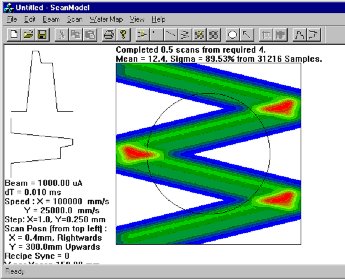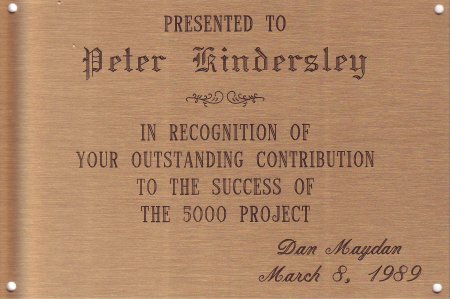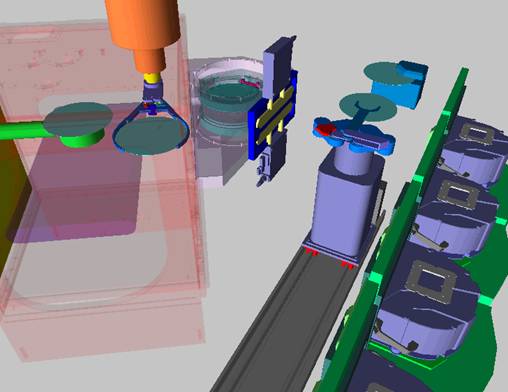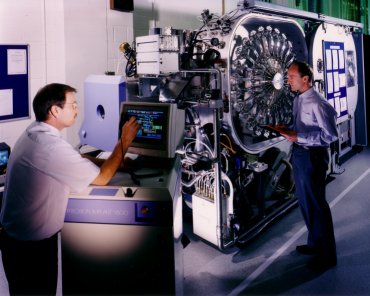Technical Projects
Technically, I am most proud of having establishing control systems that stand the tests of both time and continuously evolving requirements.
Most notably:
The Ion Implant control system, designed and authored in 1983/4, is still at the core of the current top selling high current implanter, the Applied Materials Quantum II; the P5000 Control system, designed and extensively authored in 1985/6/7, which (much evolved) still forms the basis for the majority of Applied’s cluster tool shipments today. Similarly I have established solid infrastructures for the Factory Interface on the P5000 legacy, the PI9500 (GEM) and the SWIFT platform (Gem and GEM300).
 Identified the need for a modelling tool to predict uniformity performance on the SWIFT and Batch Ion Implanters, a critical market differentiator. Developed the tool, translating the results into reports and projects, and later extended it for general use at the request of other product developments in the company.
Identified the need for a modelling tool to predict uniformity performance on the SWIFT and Batch Ion Implanters, a critical market differentiator. Developed the tool, translating the results into reports and projects, and later extended it for general use at the request of other product developments in the company.
 “Precision 5000” control code – Designed and developed the architecture and code for the Applied Materials P5000 product platform, which has formed the basis for the single most successful family of products in the Semiconductor Manufacturing Equipment market. This done against aggressive timetabling (18 month from scratch) and novel cluster tool architecture stretching the capability of the CPUs of the day – 68010 as 12.5 MHz. The small team working on the project and my high personal contribution lead to much recognition as the ‘father’ of the software, still in use 16 years later.
“Precision 5000” control code – Designed and developed the architecture and code for the Applied Materials P5000 product platform, which has formed the basis for the single most successful family of products in the Semiconductor Manufacturing Equipment market. This done against aggressive timetabling (18 month from scratch) and novel cluster tool architecture stretching the capability of the CPUs of the day – 68010 as 12.5 MHz. The small team working on the project and my high personal contribution lead to much recognition as the ‘father’ of the software, still in use 16 years later.
 Semiconductor Fab Equipment Automation – Starting in 1985, I have become the authority on implementation of the factory interface in semiconductor manufacturing equipment, able to both specify cost-effective interfaces based on customer needs, and also implement the software necessary. For example, by the end of the 1980s I was known in Intel for effective interfaces, achieving the SEMATECH GEM standard certification on the PI9500, and specifying the interface that was first (of all AMAT tools) to be signed off in Hitachi TTI, Japan.
Semiconductor Fab Equipment Automation – Starting in 1985, I have become the authority on implementation of the factory interface in semiconductor manufacturing equipment, able to both specify cost-effective interfaces based on customer needs, and also implement the software necessary. For example, by the end of the 1980s I was known in Intel for effective interfaces, achieving the SEMATECH GEM standard certification on the PI9500, and specifying the interface that was first (of all AMAT tools) to be signed off in Hitachi TTI, Japan.
 9000 Legacy code infrastructure – As a consultant to AMAT in the early 1980s, I lead the software development on the new implanter development, the 9000, putting in place a robust control system that still forms the basis of the Implant Batch tools today. Clear technical leadership and effective management of the engineers was involved, particularly as all were new to the company and implant, and a large system needed to be designed from scratch.
9000 Legacy code infrastructure – As a consultant to AMAT in the early 1980s, I lead the software development on the new implanter development, the 9000, putting in place a robust control system that still forms the basis of the Implant Batch tools today. Clear technical leadership and effective management of the engineers was involved, particularly as all were new to the company and implant, and a large system needed to be designed from scratch.
 Identified the need for a modelling tool to predict uniformity performance on the SWIFT and Batch Ion Implanters, a critical market differentiator. Developed the tool, translating the results into reports and projects, and later extended it for general use at the request of other product developments in the company.
Identified the need for a modelling tool to predict uniformity performance on the SWIFT and Batch Ion Implanters, a critical market differentiator. Developed the tool, translating the results into reports and projects, and later extended it for general use at the request of other product developments in the company. “Precision 5000” control code – Designed and developed the architecture and code for the Applied Materials P5000 product platform, which has formed the basis for the single most successful family of products in the Semiconductor Manufacturing Equipment market. This done against aggressive timetabling (18 month from scratch) and novel cluster tool architecture stretching the capability of the CPUs of the day – 68010 as 12.5 MHz. The small team working on the project and my high personal contribution lead to much recognition as the ‘father’ of the software, still in use 16 years later.
“Precision 5000” control code – Designed and developed the architecture and code for the Applied Materials P5000 product platform, which has formed the basis for the single most successful family of products in the Semiconductor Manufacturing Equipment market. This done against aggressive timetabling (18 month from scratch) and novel cluster tool architecture stretching the capability of the CPUs of the day – 68010 as 12.5 MHz. The small team working on the project and my high personal contribution lead to much recognition as the ‘father’ of the software, still in use 16 years later. Semiconductor Fab Equipment Automation – Starting in 1985, I have become the authority on implementation of the factory interface in semiconductor manufacturing equipment, able to both specify cost-effective interfaces based on customer needs, and also implement the software necessary. For example, by the end of the 1980s I was known in Intel for effective interfaces, achieving the SEMATECH GEM standard certification on the PI9500, and specifying the interface that was first (of all AMAT tools) to be signed off in Hitachi TTI, Japan.
Semiconductor Fab Equipment Automation – Starting in 1985, I have become the authority on implementation of the factory interface in semiconductor manufacturing equipment, able to both specify cost-effective interfaces based on customer needs, and also implement the software necessary. For example, by the end of the 1980s I was known in Intel for effective interfaces, achieving the SEMATECH GEM standard certification on the PI9500, and specifying the interface that was first (of all AMAT tools) to be signed off in Hitachi TTI, Japan. 9000 Legacy code infrastructure – As a consultant to AMAT in the early 1980s, I lead the software development on the new implanter development, the 9000, putting in place a robust control system that still forms the basis of the Implant Batch tools today. Clear technical leadership and effective management of the engineers was involved, particularly as all were new to the company and implant, and a large system needed to be designed from scratch.
9000 Legacy code infrastructure – As a consultant to AMAT in the early 1980s, I lead the software development on the new implanter development, the 9000, putting in place a robust control system that still forms the basis of the Implant Batch tools today. Clear technical leadership and effective management of the engineers was involved, particularly as all were new to the company and implant, and a large system needed to be designed from scratch.